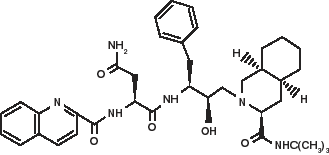

General Description:
Fortovase is a protease inhibitor developed by Roche Laboratories designed
for the clinical treatment of the human immunodeficiency virus (HIV).
It is available in a 200-mg strength soft gelatin capsule.
Mechanism:
Molecular Formula: C38H50N6O5
Molecular Weight: 670.86
See below for Molecular Structure

Saquinavir is an inhibitor of HIV protease. The protease is an enzyme required for "the proteolytic cleavage of viral polyprotein precursors into individual functional proteins found in infectious HIV. Saquinavir is a peptide-like substrate that binds to the protease active site and inhibits the activity of the enzyme". Saquinavir inhibition prevents cleavage of the viral polyproteins resulting in the formation of immature noninfectious virus particles.
Indications and usage:
Fortovase is indicated for use in combination with other anti-retroviral
drugs for the treatment of HIV infection. This indication is based
on clinical data that showed a reduction in both mortality and AIDS-related
disease for patients who recieved fortovase in combination with zalcitabine,
and/or other drug regiments.
The recommended dosage is three 200 mg capsules daily. Fortovase should be taken within two hours of completing a meal. Lower dosages have shown little or no therapeutic effect.
Precautions:
New cases of diabetes mellitus, worsening of pre-existing diabetes
mellitus and hyperglycemia have been reported during posmarketing surveillance
in HIV infected patients recieving protease-inhibitor treatment.
In some severe cases, diabetic ketacidosis has occured.
Contraindications:
Fortovase is contrainicated for patients with known hypersensitivity
to saquinavir or its components. It should NOT be administered concomitantly
with terfenadine, casapride, astmiazole, triazolam, midazolam, or ergot
derivatives.
Potential Adverse Effects:
The most frequently reported treatment emergent adverse events among
patients receiving fortovase in combination with other antiretroviral agents
were diarrhea, nausea, abdominal discomfort, and dyspepsia.
Back